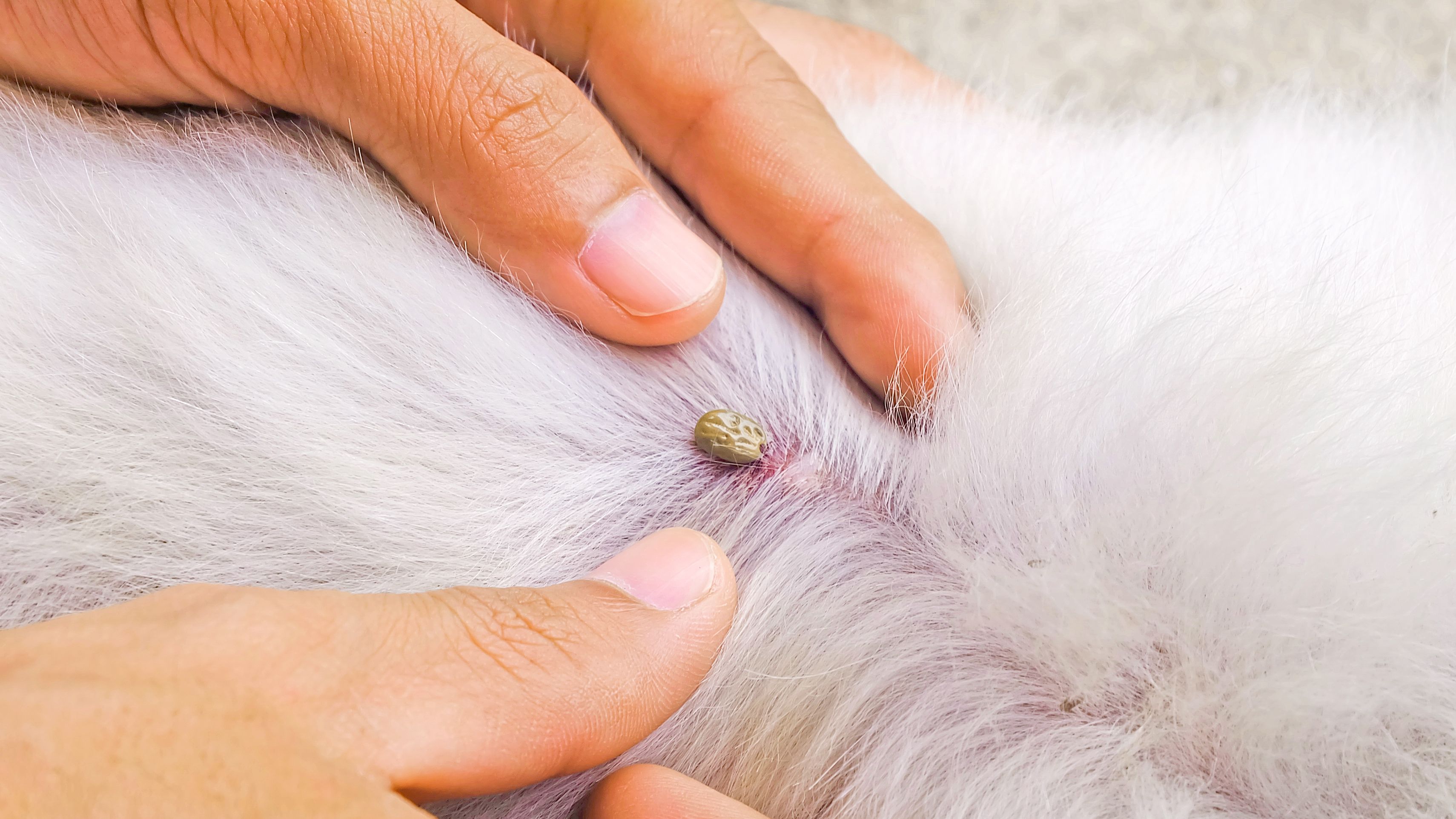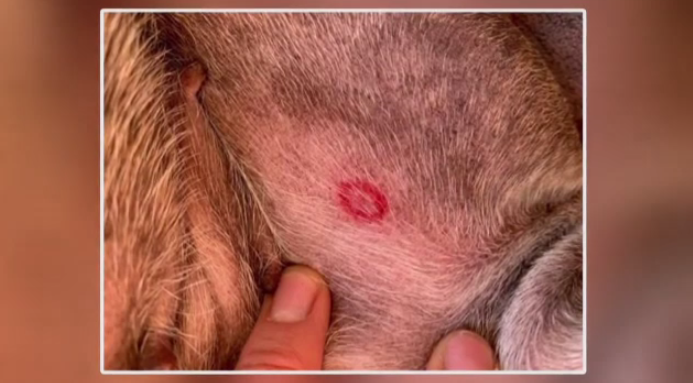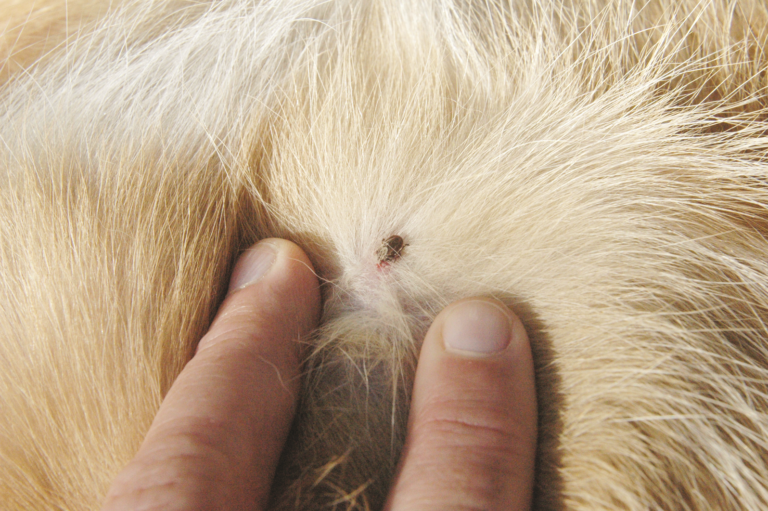Tick bites on a dog appear as small red bumps or swelling. They might also have a dark center.
These bites can lead to irritation and discomfort for the dog. It’s important to carefully inspect your dog for ticks, particularly after outdoor activities, and consult a veterinarian if you notice any signs of tick bites. Understanding the appearance of tick bites and being proactive in addressing them can help ensure your dog’s health and well-being.
Regular grooming and tick prevention methods can also reduce the risk of tick bites for your furry companion. Ticks are not only a nuisance, but they can also transmit diseases to your dog. Therefore, being vigilant about tick prevention and prompt removal is essential for your dog’s overall health. Keep reading to learn more about how to protect your dog from tick bites and the potential risks associated with them.
Identifying Tick Bites On A Dog
Tick bites on a dog can be identified by small, red, and swollen bumps on the skin. These bites may also have a dark central area where the tick has attached itself.
Physical Appearance Of Tick Bites
Tick bites on a dog can vary in their physical appearance, making it important for pet owners to know what to look out for. These tiny parasites, when attached to a dog’s skin, may leave behind distinctive marks that can be identified with a close inspection. Tick bites typically appear as small, raised bumps or red welts on your dog’s skin. They may also be accompanied by a central scab or crust, indicating that the tick has finished feeding. It’s important to note that not all tick bites will exhibit the same physical appearance, as this can vary depending on the type of tick, the duration of feeding, and the dog’s individual reaction to the bite.Common Locations For Tick Bites
Ticks can bite your dog almost anywhere on their body, but there are certain areas that are more commonly targeted. These locations are ideal for ticks as they provide warm and protected areas for them to attach and feed. Some of the most frequently affected areas include the head, neck, ears, and paws. Checking your dog’s ears thoroughly is crucial, as ticks tend to favor this sensitive area. Other common locations to inspect are the armpits, groin, between the toes, and under the tail. Remember, ticks can be skillful at hiding, so be sure to perform a comprehensive examination of your dog’s entire body, especially after they have been in wooded or grassy areas.In conclusion, identifying tick bites on your dog involves inspecting their skin for small raised bumps or red welts, sometimes accompanied by a central scab or crust. These bites can occur in various locations on your dog’s body, with certain areas being more prone to infestation. Regular tick checks and prompt removal are essential in preventing tick-borne diseases and ensuring your dog’s well-being.
Credit: www.prevention.com
Signs Of Tick Infestation
Tick bites on a dog can be harmful and may go unnoticed if not carefully inspected. It is essential to be aware of the signs of tick infestation in dogs, as early detection can prevent further health issues. Understanding the appearance of tick bites and related symptoms can help dog owners take prompt action and seek appropriate treatment.
Visible Ticks On The Dog
If you notice small, dark, or reddish-brown creatures attached to your dog’s skin, they may be ticks. Ticks can vary in size, from as small as a poppy seed to as large as a pencil eraser, depending on their life stage and how long they have been feeding. Inspect your dog’s skin thoroughly, paying close attention to areas such as the paws, ears, and around the face, where ticks often like to attach themselves.
Presence Of Tick-related Symptoms
- Excessive scratching or licking: Observe if your dog is constantly scratching or grooming certain areas of its body, as this could indicate discomfort caused by tick bites.
- Redness and swelling: Check for inflammation and redness around the bite area, which may be a sign of a tick infestation.
- Lethargy: If your dog appears unusually tired or unenergetic, it could be a sign that the tick bite is affecting their overall health.
- Loss of appetite: A sudden decrease in appetite could be an indication of a tick-borne illness affecting your dog.
Potential Complications Of Tick Bites
Tick bites on a dog can lead to potential complications, including skin irritation, itchiness, redness, and in some cases, transmission of diseases like Lyme disease or babesiosis. Immediate examination and proper treatment by a veterinarian are crucial to prevent further harm to the dog’s health.
Transmission Of Tick-borne Diseases
Tick bites on dogs can lead to the transmission of dangerous diseases. These blood-sucking parasites can transmit various diseases such as Lyme disease, Ehrlichiosis, Anaplasmosis, and Rocky Mountain spotted fever. Ingesting the pathogens carried by ticks can expose dogs to the risk of contracting these potentially severe illnesses. This underscores the importance of promptly removing ticks and seeking veterinary care if a dog has been bitten.Allergic Reactions To Tick Bites
Some dogs may experience allergic reactions to tick bites. When a tick attaches to a dog and starts feeding, it releases saliva with a cocktail of potentially allergenic compounds that can trigger an allergic response in sensitive individuals. The allergic reactions can manifest as itching, redness, swelling, and hives around the bite site. In severe cases, dogs may experience anaphylaxis, a life-threatening allergic reaction that requires immediate veterinary attention to manage.By addressing tick bites promptly and seeking appropriate veterinary care, these potential complications can be minimized, ensuring the well-being of our furry companions.
Credit: www.kingsdale.com
Preventing And Treating Tick Bites
Tick bites on a dog appear as small, red bumps or sometimes as a scab. The affected area may be itchy or inflamed. It’s crucial to check your dog regularly and remove ticks promptly to prevent diseases. Consult a vet if you notice any unusual signs or symptoms.
Ticks are not just a nuisance for dogs, but they can also pose serious health risks. Knowing how to prevent and treat tick bites is essential for keeping your furry friend safe and healthy. By following a few simple methods, you can greatly reduce the chances of your dog getting bitten by ticks. If your dog does end up with a tick bite, proper removal and treatment are crucial to minimize any potential complications.Tick Prevention Methods
Preventing tick bites is the first line of defense against these tiny parasites. Here are some effective tick prevention methods you can implement to keep your dog tick-free:1. Regularly check your dog for ticks: Thoroughly inspect your dog’s coat, paying close attention to areas where ticks commonly attach, such as around the ears, between the toes, and in the groin area. Remove any ticks immediately if you find them. 2. Use tick prevention products: Consult with your veterinarian to choose an appropriate tick preventive product for your dog. Options may include spot-on treatments, tick collars, or oral medications. Follow the instructions carefully to ensure maximum effectiveness.3. Create a tick-resistant environment: Keep your outdoor space well-maintained by mowing the grass regularly and removing any tall weeds or brush. Consider using fencing to restrict access to tick-infested areas, such as wooded areas or tall grass.4. Avoid tick habitats: When taking your dog for walks or hikes, try to stick to open areas and avoid dense vegetation where ticks are more likely to be found. Stay on trails and keep your dog away from leaf piles and tall grass.Removing And Treating Tick Bites
Despite our best efforts, dogs can still end up with tick bites. Here’s what you should do if you discover a tick on your furry friend:1. Use a tick removal tool: Grab a pair of fine-tipped tweezers or a tick removal tool specifically designed for this purpose. Grasp the tick as close to the skin as possible and steadily pull upward with steady pressure. Do not twist or jerk the tick, as this can cause parts of its mouth to break off and remain embedded in the skin.2. Clean the bite area: Once the tick has been successfully removed, thoroughly clean the bite area with mild soap and water. This helps prevent any potential infection. Observe the bite site over the next few days for any signs of inflammation or infection.3. Monitor your dog for tick-borne diseases: Keep a close eye on your dog for any symptoms of tick-borne diseases, such as lethargy, loss of appetite, fever, or joint pain. If you notice any unusual behaviors or symptoms, seek veterinary attention immediately.Remember, prevention is always better than cure, so make tick prevention a priority for your dog’s well-being. By taking the necessary precautions and promptly treating tick bites, you can keep your furry friend safe and happy during tick season.Seeking Veterinary Care
When it comes to tick bites on a dog, seeking veterinary care is crucial. Tick bites can be more than just a nuisance for our furry friends, as they can transmit diseases that can lead to serious health problems. If you notice any signs of tick bites on your dog, it’s important to consult a veterinarian as soon as possible. Veterinary care is essential to ensure the well-being of your dog and to prevent any complications that may arise from tick-borne illnesses.
When To Consult A Veterinarian
If you find a tick embedded in your dog’s skin, it’s recommended to consult a veterinarian. However, there are other situations where seeking veterinary care becomes necessary:
- If your dog shows signs of illness after being bitten by a tick, such as fever, lethargy, loss of appetite, or lameness
- If you notice any unusual swelling or redness at the site of the tick bite
- If the tick’s head or mouthparts remain embedded in your dog’s skin after removal
- If your dog experiences any adverse reactions to tick preventive medications
It’s important to remember that early intervention plays a vital role in preventing the spread of tick-borne diseases in dogs. Therefore, if you’re unsure whether or not your dog requires veterinary care, it’s always best to err on the side of caution and consult a professional.
Tests And Treatment Options
When you bring your dog to the veterinarian for tick bite evaluation, several tests may be performed to assess their overall health and assess for potential tick-borne diseases. These tests may include:
- Complete blood count (CBC) to check for any abnormalities in blood cell counts
- Chemistry panel to evaluate organ function and detect any underlying health conditions
- Tick testing to identify the species of tick and determine if it carries any diseases
Once the potential tick-borne diseases have been identified, the veterinarian will recommend suitable treatment options for your dog. Depending on the situation, treatment may involve:
- Administering appropriate medications to eliminate the tick-borne disease
- Prescribing antibiotics to combat any secondary bacterial infections
- Providing supportive care to address symptoms and promote recovery
Tick bites on dogs can range from mild to severe, so it’s essential to seek veterinary care to ensure the best possible outcome for your furry friend. Remember, prevention is always better than cure, so be proactive in protecting your dog by using preventive measures and seeking timely veterinary care.

Credit: kitchener.ctvnews.ca
Frequently Asked Questions On What Do Tick Bites On A Dog Look Like
What Does A Tick Bite On A Dog Look Like?
A tick bite on a dog may appear as a small, raised bump or a red spot on the skin. It can sometimes be accompanied by swelling or irritation. It is important to carefully examine your dog’s fur and skin for ticks, as they can transmit diseases and cause discomfort to your furry friend.
How Do I Know If My Dog Has A Tick Bite?
You can check for tick bites on your dog by carefully inspecting their skin and fur. Look for small, raised bumps or red spots, especially in areas where ticks are commonly found, such as the ears, neck, and paws. If you find a tick attached to your dog’s skin, it is important to remove it promptly and monitor for any signs of illness.
Are Tick Bites Dangerous For Dogs?
Tick bites can be dangerous for dogs as ticks can transmit diseases such as Lyme disease, Ehrlichiosis, and Anaplasmosis. If left untreated, these diseases can cause serious health issues for your dog. It is important to take preventive measures and regularly check for ticks to protect your furry friend from potential harm.
How Do I Remove A Tick From My Dog?
To safely remove a tick from your dog, use fine-tipped tweezers to grasp the tick as close to the skin as possible. Gently pull upward with a steady motion, making sure to remove the entire tick, including its head. Avoid squeezing or twisting the tick, as this may increase the risk of infection.
After removal, clean the bite area with antiseptic and monitor your dog for any signs of illness.
Conclusion
To sum up, recognizing tick bites on your dog is crucial for their well-being. These bites often appear as small, raised bumps on your dog’s skin. It’s important to monitor your furry friend for any signs of ticks, such as excessive itching or scratching.
Regular grooming, tick prevention measures, and immediate removal of ticks are essential in keeping your dog safe from tick-borne diseases. By staying vigilant and seeking veterinary care if needed, you can ensure your canine companion stays healthy and happy.



